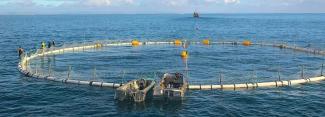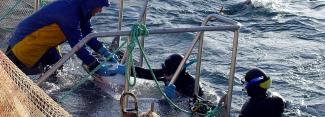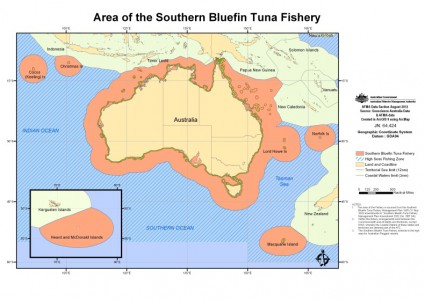The Australian Southern Bluefin Tuna Fishery is managed by limiting the catch of southern bluefin tuna. In this fishery, fish are caught in a net and transferred to floating pontoons, where they are raised until they are big enough to be sold.
Southern bluefin tuna is also caught by many other countries. Australia’s catch of southern bluefin tuna is a part of the total catch internationally.


Target Species
| Species | Fishing Mortality* | Biomass** |
|---|---|---|
Thunnus maccoyii | G;Not subject to overfishing | G;Not overfished |
* Fishing mortality status relates to the level of fishing pressure on a stock – specifically, whether fishing mortality in the year being assessed is likely to result in the stock becoming overfished, or prevent the stock from rebuilding from an overfished state. If fishing mortality exceeds either of these thresholds, a stock is considered to be subject to overfishing.
** Biomass status relates to how many fish there are – specifically, whether the biomass in the year being assessed is above the level at which the risk to the stock is considered to be unacceptable. The HSP defines this level as the limit reference point, below which the stock is considered to be overfished.
Allowable commercial catch
| Species | 2025–26 allowable catch (tonnes) | 2024–25 allowable catch (tonnes) | 2023–24 allowable catch (tonnes) | 2022–23 allowable catch (tonnes) | 2021–22 allowable catch (tonnes) |
|---|---|---|---|---|---|
| Southern Bluefin Tuna | 6930* | 6930* | 6930* | 5926.5* | 5926.5* |
*note – 5 per cent of the CCSBT annual catch allowance had been set aside for recreational fishing.
SFR conversion factor
For the 2025–26 season the live weight value has been set at 1.30159668 kg/SFR.
Total fishery value
$A 46.87 million in 2023–24.
Fishing gear
Pelagic longline and purse seine fishing gear is used in this fishery.
In Australia, commercial fishers mainly use the purse seine fishing method to catch southern bluefin tuna. After being caught, these fish are towed closer inshore and transferred to permanent floating farms called pontoons. They stay in these pontoons for several months, where they grow bigger before being harvested and sold frozen, mainly to Japanese markets.
Southern bluefin tuna are also commonly caught off the New South Wales coastline. In this area, fishers catch these fish using the longline fishing method.
Read more about longline fishing.
Read more about purse seine fishing.
Location
The Southern Bluefin Tuna Fishery covers the entire sea area around Australia, out to 200 nm from the coast.
Major landing ports
Port Lincoln, Ulladulla, Bermagui.
Markets supplied
Fresh and frozen product – Australia, Japan and USA.
Fishing season
12 month season, beginning on 1 December.
Management of catch
This fishery is managed under a quota system that limits the amount of fish that boats can take. This quota limit is also known as a total allowable catch. Under this system, each fisher is limited to catching up to the amount of quota that they hold and the whole fishery is limited to the total allowable catch that is set each season. Setting quotas is one of the main methods AFMA uses to ensure these fish species remain sustainable.
Each year the AFMA Commission decides on the total allowable catch using information provided by scientists, the fishery manager and industry members. The Southern Bluefin Tuna Management Advisory Committee recommend to the AFMA Commission what they think the allowable catch should be each season.
Southern bluefin tuna is also managed internationally. This means the current stock status is for the global catch of this species. Operators in the Southern Bluefin Tuna Fishery only catch a part of the total international catch.
International management
Southern bluefin tuna is highly migratory, meaning that they swim over large distances and between different countries. For this reason, this species is also managed internationally.
The international Commission for the Conservation of Southern Bluefin Tuna is made up of eight participating member countries, including Australia. The Commission sets an annual total allowable catch limit for each member country and AFMA applies Australia’s total allowable catch limit each year to our commercial Southern Bluefin Tuna Fishery. The Southern Bluefin Tuna Management Advisory Committee reviews the international and domestic science and management of southern bluefin tuna and provides advice to the AFMA Commission.
Licence to fish
To fish in this fishery, fishers need to hold statutory fishing rights allocated by AFMA.
Statutory fishing rights allow fishers to fish in the fishery and catch the fish species that are under a quota. Statutory fishing rights are transferable between fishers and they are also known as individual transferable quota.
Collecting data
Data about the catch and effort of the fishery is collected from the logbooks that fishers have to fill out. Logbooks record:
- the species and amount caught
- catch that is discarded
- the catch/release of any protected species and their life status
- time and location of fishing activities
- the type of gear used.
Species sustainability
The CCSBT management procedure specifies that there should be a full quantitative stock assessment every 3 years. In 2023, a revised CCSBT operating model (the quantitative model that is used to assess the spawning biomass of southern bluefin tuna, based on a variety of data sources), using data up to and including 2022, was used to run various scenarios to determine the impact of fishing on the stock.
The updated assessment incorporated the half-sibling pair data from a close-kin genetic study, as well as parent–offspring pair data and data derived from the gene-tagging program. Similar to 2020, the 2023 assessment used an estimate of total reproductive output (TRO) instead of biomass of fish 10 years and older, due to the inclusion of the close-kin data. TRO is the absolute abundance of successfully reproducing adults in the population. The reference set of operating models (or base case) for the assessment indicated that TRO is at 23% of the initial or unfished level (80% CI 21-29%). The ratio of current fishing mortality to the level associated with maximum sustainable yield (FMSY) was 0.85 (80% CI 0.61–1.29).
Australia (ABARES, 2024):
- Southern bluefin tuna – Fishing mortality – Not overfished, Biomass – not subject to overfishing.
Fishery closures
There are currently no specific closures to fishing in the fishery.
Species risk assessments
AFMA regularly monitors the effects fishing activities have on marine species, habitats and communities through ecological risk assessments. The assessment results help to prioritise the management, research, data collection and monitoring needs for the fishery.
After the risk assessment is complete, an ecological risk management strategy is developed to set out how AFMA will manage marine species, habitats and communities identified in the assessment as greatly impacted by commercial fishing operations.
Read the most recent assessment and strategy for the Southern Bluefin Tuna Fishery.
Bycatch and discarding
There is very little bycatch and discarding in the Southern Bluefin Tuna Fishery.
The purse seine fishing gear used by the majority of southern bluefin tuna fishers is very selective as the net can be set around a single school of fish near the water surface.
Harvest strategy
The Southern Bluefin Tuna Fishery is managed internationally. The Commission for the Conservation of Southern Bluefin Tuna (CCSBT) has developed a Management Procedure for southern bluefin tuna and this is used to set the total allowable catch limits for each member country, including Australia. The Management Procedure is very similar to a harvest strategy and uses catch and effort data and independent scientific information to determine what the total allowable catch should be.
Read the CCSBT Management Procedure for Southern Bluefin Tuna.
Export approvals
To export from an Australian commercial fishery, the fishery must be approved as a wildlife trade operation by the Department of Climate Change, Energy, the Environment and Water under the Environment Protection and Biodiversity Conservation Act 1999 (EPBC Act).
The Southern Bluefin Tuna Fishery was declared an approved wildlife trade operation for a further three years in 2022. This allows southern bluefin tuna to be exported until 11 November 2025. The Department of Climate Change, Energy, the Environment and Water (DCCEEW) has included several recommendations on the wildlife trade operation approval and AFMA must adhere to these throughout the three-year period.
Read the details of the Southern Bluefin Tuna Fishery wildlife trade approval and conditions.
Marine reserves
Commonwealth marine reserves are areas established under Australian environmental law to help conserve the spectacular marine life in our oceans. They allow ecologically sustainable use of our marine resources and provide special places for people to enjoy and appreciate the fantastic diversity of our marine habitats.
Marine reserves are sometimes known as marine protected areas or marine parks. These areas are managed by Parks Australia and DCCEEW.
Fishing in the fishery
Fishing operators wanting to fish in the Southern Bluefin Tuna Fishery must hold quota statutory fishing rights for southern bluefin tuna.
For a full description of all fishing requirements for the purse seine sector of the Southern Bluefin Tuna Fishery, please see the Southern Bluefin Tuna Fishery pre-season brief under Fishery Publications below.
Fishery legislation
The management of the Southern Bluefin Tuna Fishery is also governed by other legislation.
The Southern Bluefin Tuna Fishery Management Plan 1995 came into effect in 1995.
Fisheries management involves a broad range of stakeholders; such as industry, scientists, environmental groups and the community.
Fishing industry
Each fishing season, AFMA officers visit the major fishing ports of the Southern Bluefin Tuna Fishery. These visits allow AFMA to meet directly with fishers to discuss any concerns they might have, and also gain current information on the trends in fishing and catches during the season. This information is useful for the continuing management of the fishery.
Southern Bluefin Tuna Management Advisory Committee
The Southern Bluefin Tuna Management Advisory Committee (SBTMAC) is the advisory body for the Southern Bluefin Tuna Fishery. The SBTMAC includes representatives from AFMA, industry, scientific agencies, environmental non-government organisations (eNGOs), and the recreational/charter fishing sector. One meeting is held each year to discuss any problems relating to this fishery, review scientific information and develop possible management measures.
For a summary of the latest discussions and outcomes from SBTMAC and a list of the current members, please see the Southern Bluefin Tuna Management Advisory Committee webpage.
Recreational fishing
Southern bluefin tuna is also an important recreational fishing species. The recreational fishing of this species is managed by the relevant state governments.
In 2020, AFMA amended the Southern Bluefin Tuna Management Plan 1995 to implement the government’s commitment to set aside five per cent of Australia’s CCSBT allocation for recreational fishing mortality.
Information for responsible catching, handling, releasing and tagging of Southern Bluefin Tuna can be found in the Southern Bluefin Tuna Code of Practice – Recreational Fishery.
Government departments
AFMA works closely with other government departments, such as the Department of Agriculture, Fisheries and Forestry and the Department of Climate Change, Energy, the Environment and Water. They help in providing advice and guidance on both domestic and international fisheries issues.
State governments
The Australian state governments manage fishing from the Australian coast out to 3 nm. Occasionally there is some overlap in fishing operations between the state and Commonwealth jurisdictions and AFMA regularly communicates with the state government fisheries agencies to manage any problems.
Environmental non-government organisations
Representatives from environmental non-government organisations (eNGOs) attend the Southern Bluefin Tuna Management Advisory Committee meetings and provide input and advice.
Management publications
Southern Bluefin Tuna Fishery Management Plan
2024–25 Southern Bluefin Tuna Fishery Farm Sector pre-season brief
2023–24 Southern Bluefin Tuna Fishery Farm Sector pre-season brief
2022–23 Southern Bluefin Tuna Fishery Farm Sector pre-season brief
Environment publications
Ecological risk management reports
Research plan
There are several maps that are relevant to the Southern Bluefin Tuna Fishery. The first map below shows the sea area that is included in the fishery.

Between May and October, the waters off NSW and Victoria are cooler and Southern Bluefin Tuna migrate through these areas. Fishers in the Eastern Tuna and Billfish Fishery are also allowed to catch Southern Bluefin Tuna during these months. To manage the catch of Southern Bluefin Tuna off the Australian east coast, AFMA puts specific zones in place, which are reviewed weekly and are set in relation to sea surface temperature and currents. For the current map of the Southern Bluefin Tuna Management Zones, please see the SBT Zone page.
AFMA uses many methods to monitor the compliance of fishing activities and collect data on fish stocks. These include:
Onboard observers
One of the main monitoring methods used by AFMA is onboard scientific observers. These observers are people employed by AFMA to go out on boats and independently record the catch, effort and biological information of each fishing trip.
They take samples from fish, such as the otoliths or ear bones, and use these to determine the age of the fish caught.
Observers also record the length, weight and sex of each fish caught during a trip and report on the other wildlife that may be seen, the weather conditions, the composition of commercial catch fate of species that are caught as bycatch.
Boats in the Southern Bluefin Tuna Fishery must carry an AFMA observer when requested by AFMA.
Read more about the Observer program.
Satellite tracking
A satellite monitoring system called a Vessel Monitoring System or VMS for short, is fitted to each concession holders boat. This system helps AFMA to monitor vessel position, course and speed. The tracking unit regularly transmits the information through a communications satellite to a land earth station. This information is sent by secure internet connection to a database at AFMA.
Read more about our satellite tracking program.
Cameras on fishing boats – electronic monitoring
AFMA has electronic monitoring systems on some fishing boats. These systems have sensors linked to surveillance cameras that record fishing activity such as the impacts of some fishing methods on protected species. These recordings can then be collected and monitored by AFMA. Electronic monitoring gives fishers a cost effective way to support monitoring and data collection.
Read more about our electronic monitoring program.